Article's Content
Welcome to Volume 73!
It’s been a tough week for the whole world, especially the dear folks in Ukraine.
While we advocate for peace, it’s important we show our support in any way we can. It could be sending a donation or opening your home to someone in need.
Please do whatever you can in your capacity to support employees, friends, family, and anyone else affected by this crisis. Your contribution can go a long way in helping people find comfort and hope, despite all that’s happening.
Many thought leaders and companies in the B2B space have led by example this past week, going the extra mile to support Ukraine.
Before we dive into today’s stories, here’s a peek at what’s to come in this piece:
- Ahrefs & Other SaaS Companies Support Ukraine
- Steal Dreamdata’s LinkedIn Playbook
- Two Bootstrapped Startups Who Became Unicorns
Ahrefs & Other SaaS Companies Support Ukraine
On February 24th, the world watched as Russia began a full-scale invasion of Ukraine.
My heart bled as I saw pictures and videos on my LinkedIn feed, showing the ruins of the Russo-Ukrainian war.
Numerous lives have been lost since the invasion. Many have lost their loved ones, jobs, homes, and more. Some managed to flee the country while others are still stuck in Ukraine. We send our love and support to the people of Ukraine.
Amid the chaos, I saw a lot of B2B SaaS brands and creators lay down ambitions and goals to empathize and support Ukraine however they could.
Ahrefs’ CMO, Tim Soulo, dedicated this Twitter thread to spread truthful, actual information about the military invasion:

Having a trusted voice in the marketing space take charge of spreading the right info is helpful in a time like this. We all know how some media outlets can attempt to conceal, water down, or blow happenings out of proportion.
Ahrefs also took it a step farther to help raise awareness and funding for Ukraine.
If you use Ahrefs, you’ll have noticed the banner promising an extension of subscription for double the amount donated:

Chili Piper also jumped on the opportunity to show their support, offering to relocate Ukrainian and Russian employees, amongst other things:

OpenPhone thought of a way to connect people to their loved ones in Ukraine: they made calls and messages free:
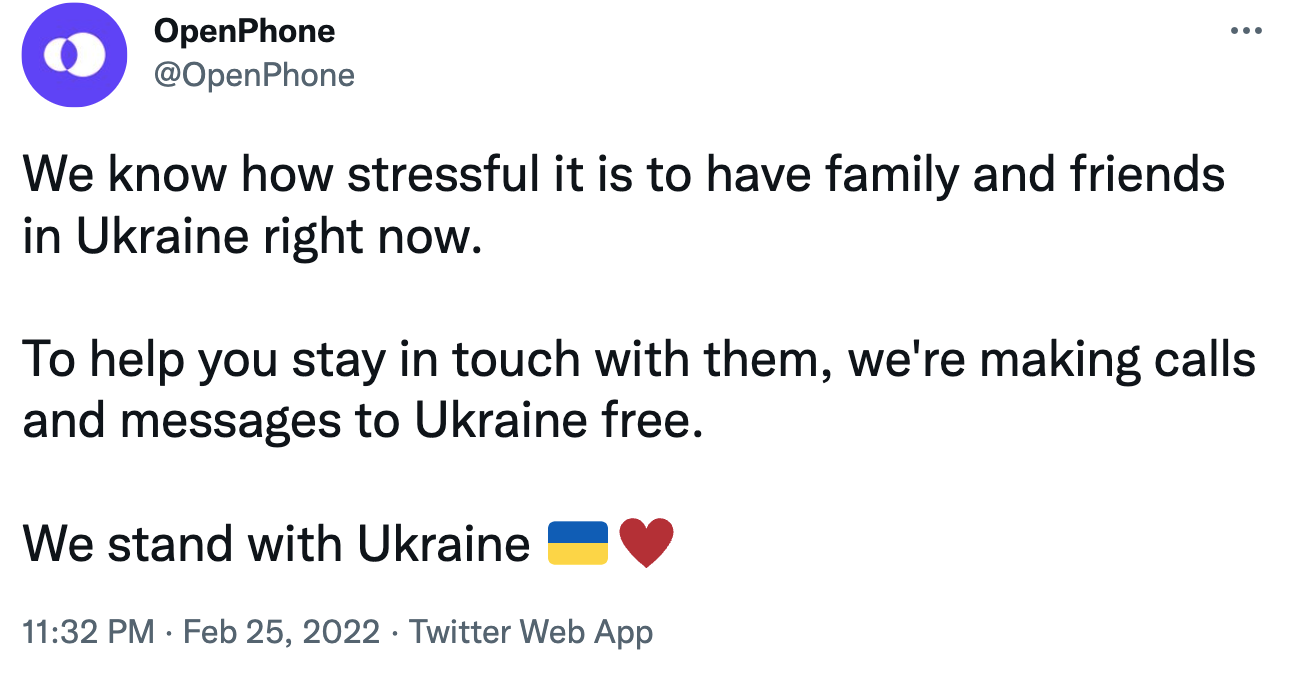
Industry leaders weren’t left out of the mix. Senior Product Manager at Wise, Pavlo Pedenko, and two other product leaders launched this asset on Product Hunt:
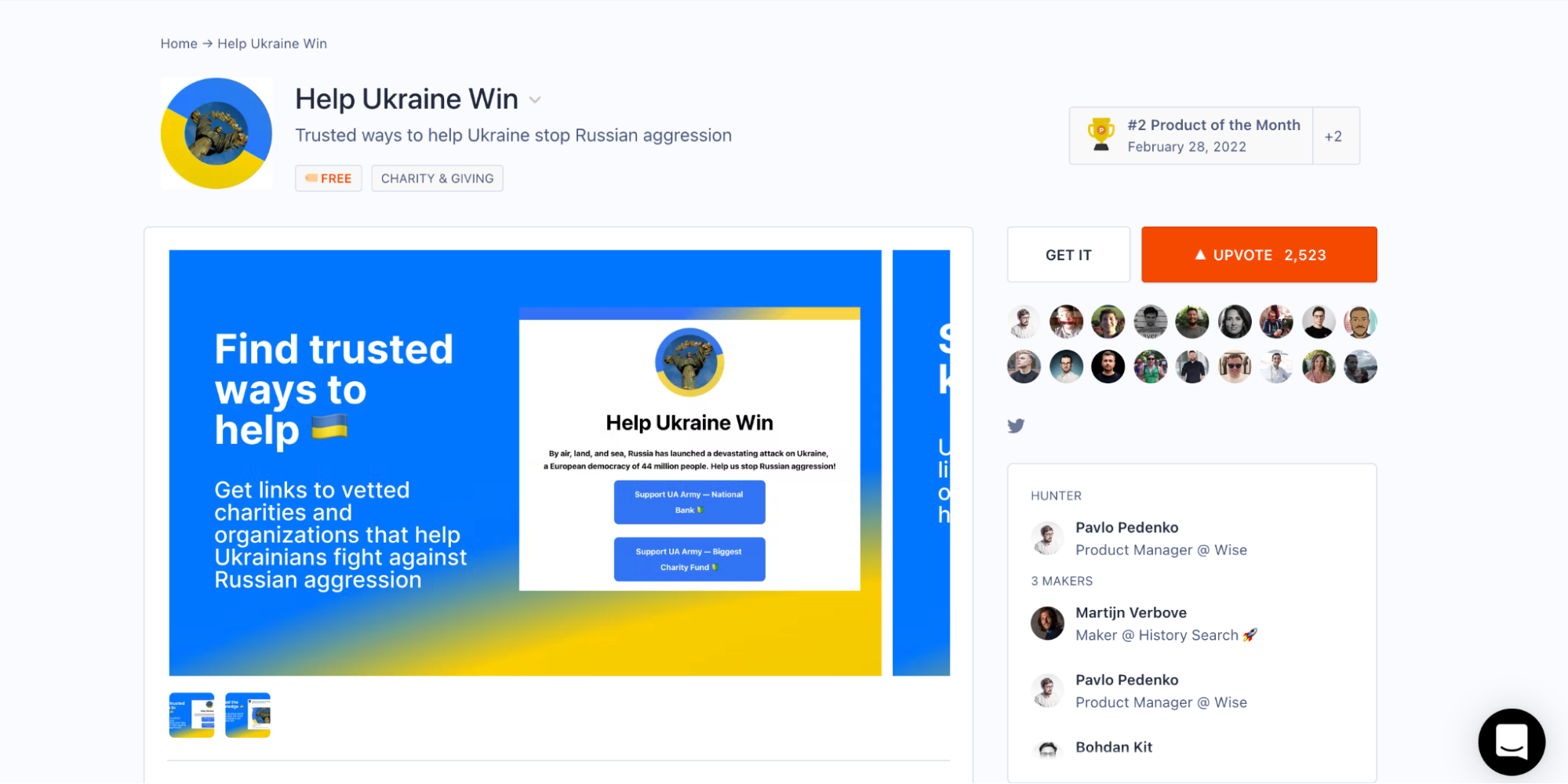
The product offered helpful ways to support Ukraine, and in less than five days, it rose to become the second most popular product of the month.
VidIQ, whose employees are mostly Ukrainian, shared links to help users and visitors know how to support Ukrainians during these tough times.

There are also a ton of other brands and industry influencers doing the same.
It’s heart-warming to see brands dedicate some time to helping real people wade through crises. Not everything has to be an acquisition move. Crisis seasons present an opportunity for brands to prioritize giving back and giving more over earning more.
If you would like to support Ukraine, here are a few ways to do it:
- https://wck.org/donate
- https://www.comebackalive.in.ua/donate
- https://mkip.gov.ua/en/content/volonterski–organizacii.html
KEY TAKEAWAYS:
- On February 24th, Russia began a full-scale invasion of Ukraine.
- Many B2B brands and creators lay down ambitions and goals to empathize and support Ukraine however they could.
- A tough season like this one presents an opportunity for brands to prioritize giving back and giving more over earning more.
- You can support Ukraine via this link or this.
Steal Dreamdata’s LinkedIn Playbook
Last week, one of my colleagues shared an interesting piece in our #nicefinds Slack channel. Dreamdata’s case study broke down how 6 of its employees generated over 520K views and lots of reactions on LinkedIn in 91 days.
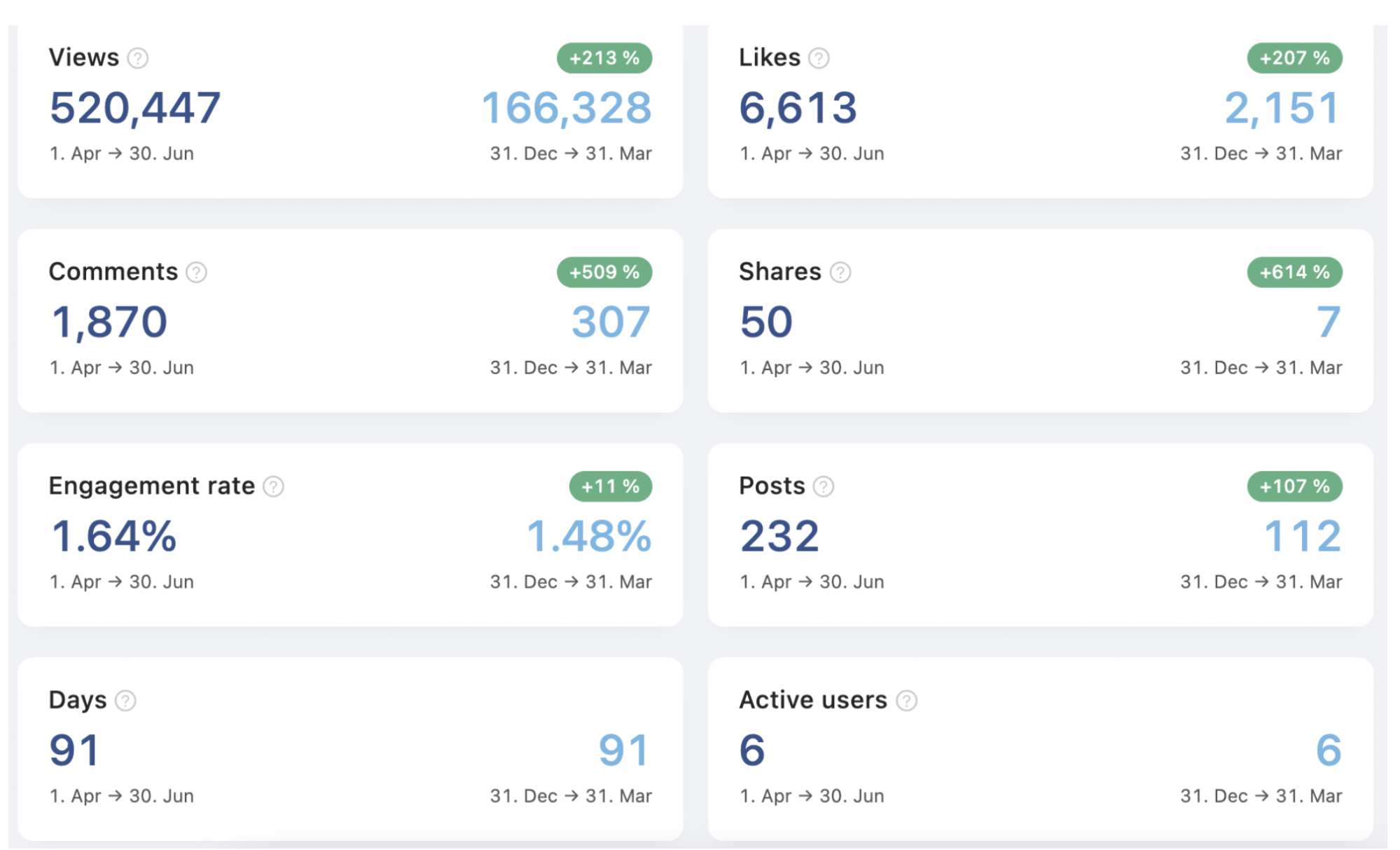
Their strategy?
Social selling.
If you are unfamiliar with social selling, it means using your network to find the right prospects, build trust, establish stronger relationships, and hit your revenue goals. Employees can also use their network to do the same.
Dreamdata’s social selling journey started a year ago with one employee’s post on LinkedIn. Account Executive Laura Erdem shared a recent win, her process, and key takeaways from the win.
The single post generated almost 40,000 views on Linkedin, and the most website visitors and MQLs recorded before that day:
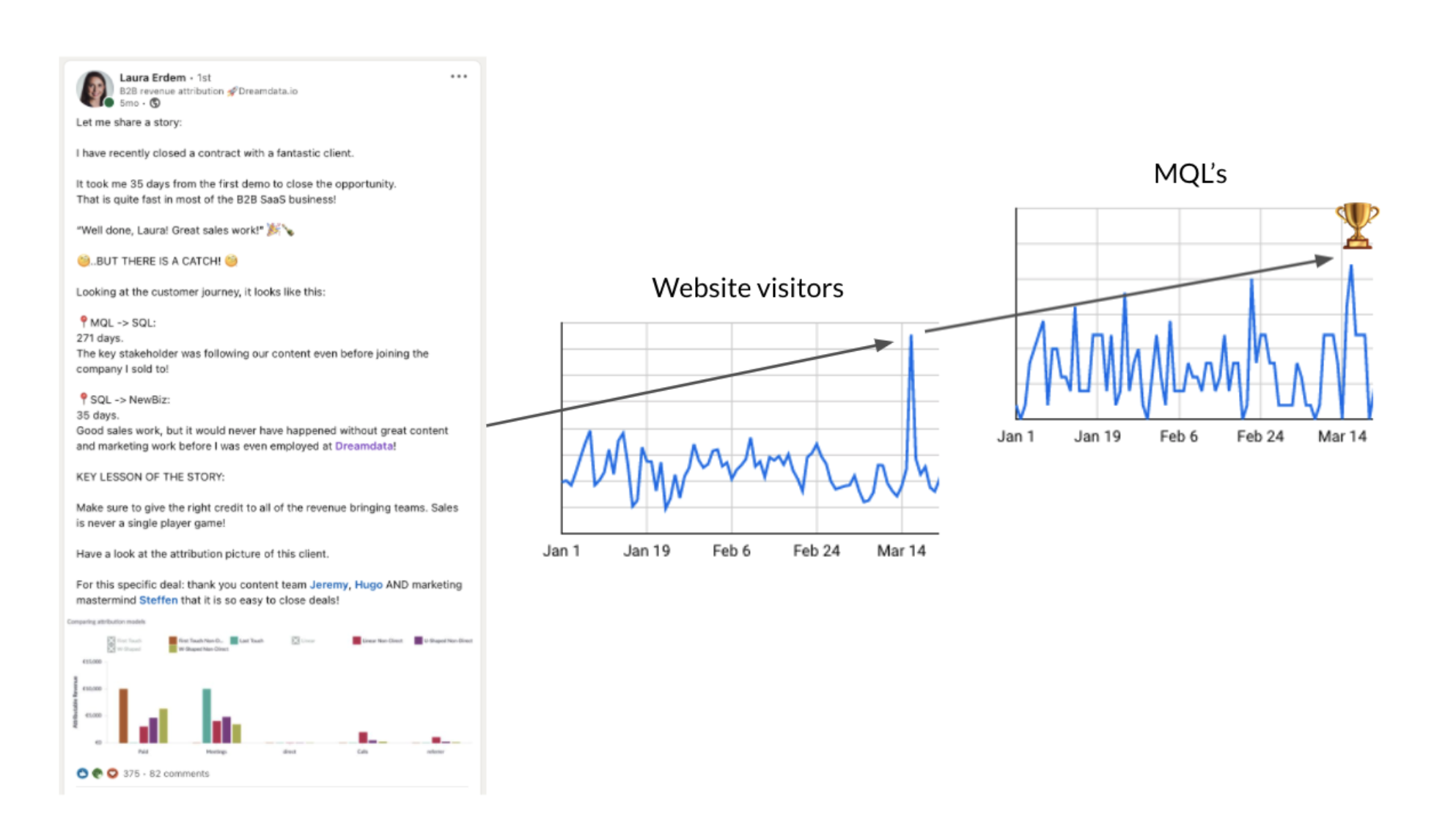
These results drove Dreamdata co-founders Steffen Hedebrandt and Lars Grønnegaard Hansen and four other team members to experiment with social selling. The goal was to see how joint team effort would affect the bottom line.
Dreadata didn’t have any specific plan. However, they built as they learned on the go.
Here’s what their playbook looks like.
1. Set a goal and get employee buy-in
Dreamdata’s goal was to reach 300K views from all six team members’ efforts. But they didn’t stop there. They also had something to look forward to: a team dinner at the end of the quarter if they hit the target.
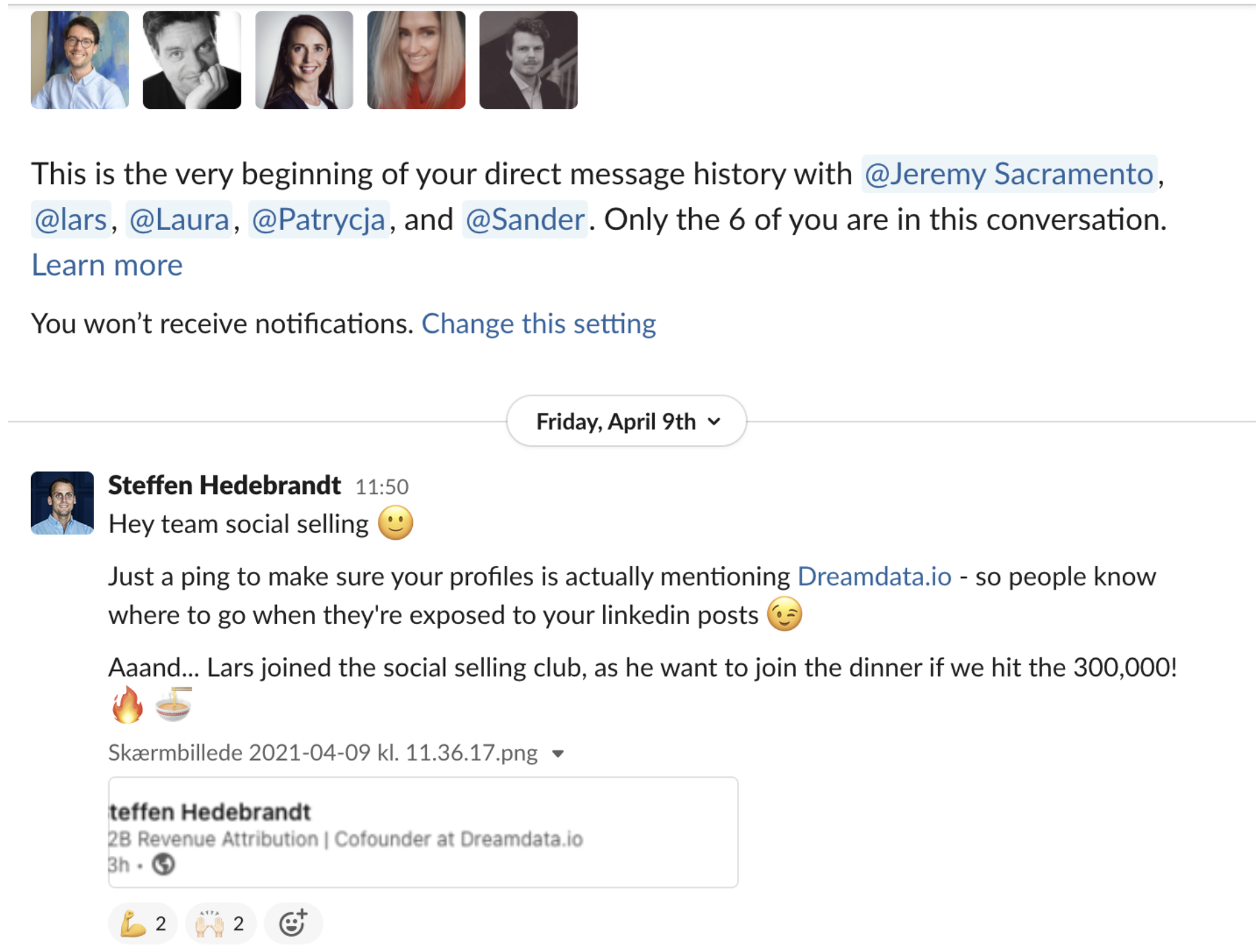
2. Set some ground rules on the go
The Dreamdata team didn’t waste any time overthinking and overplanning their execution strategy. Instead, they jumped in and figured things out as they went.
First, they used a uniform banner and updated their profiles to show the company’s name. See how these two profiles appear similar:

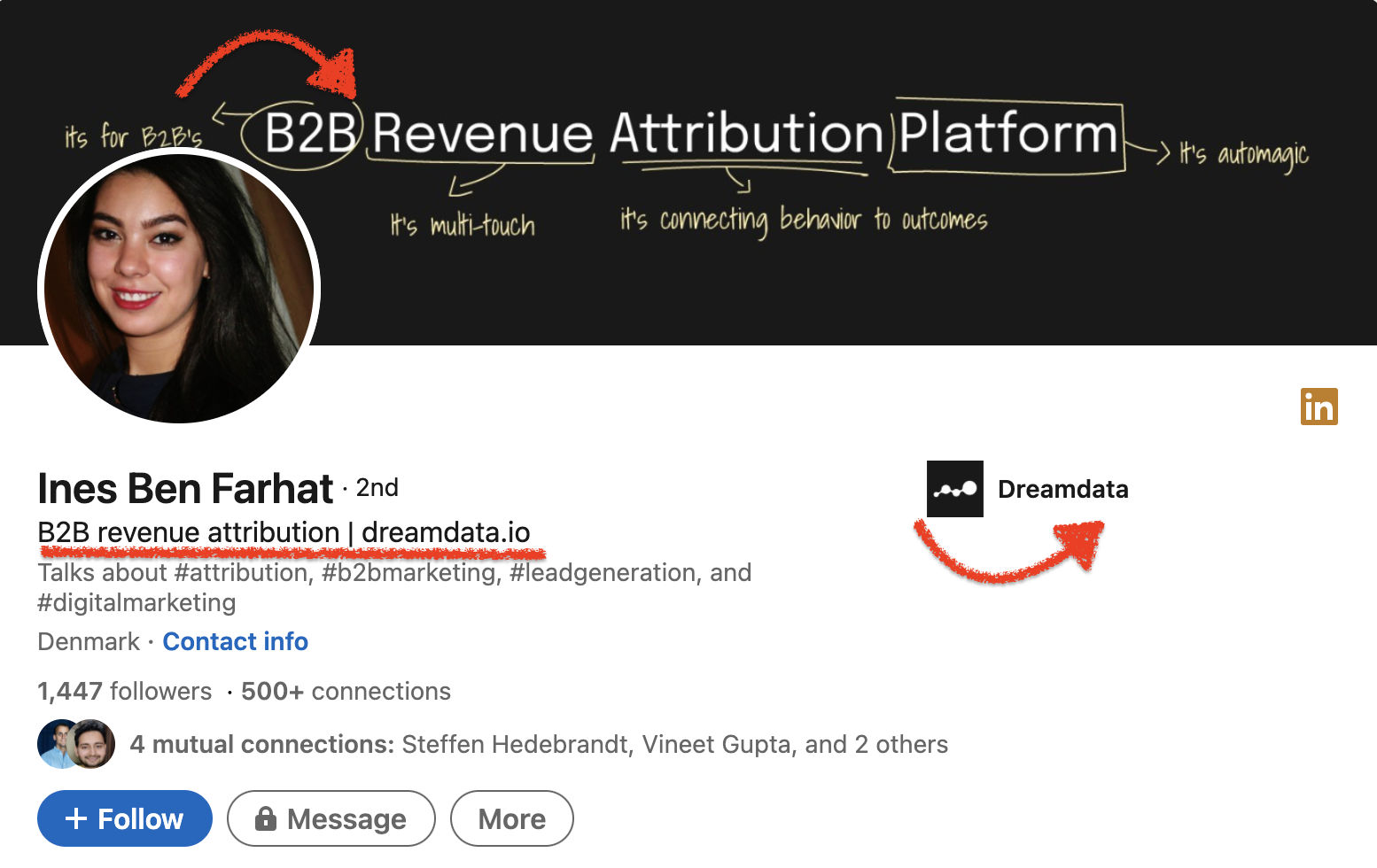
Their titles both have the company name and value proposition. Also, their header image is the same. This consistency in identity somehow sticks in the hearts of people who follow them and check out their content regularly.
The team shared compelling customer-centric content that didn’t focus solely on the product itself. They focused more on adding value to users, leveraging content types an employee is best known for.
One of the best-performing posts was a meme with a short lesson on attribution and no direct mentions of the product.
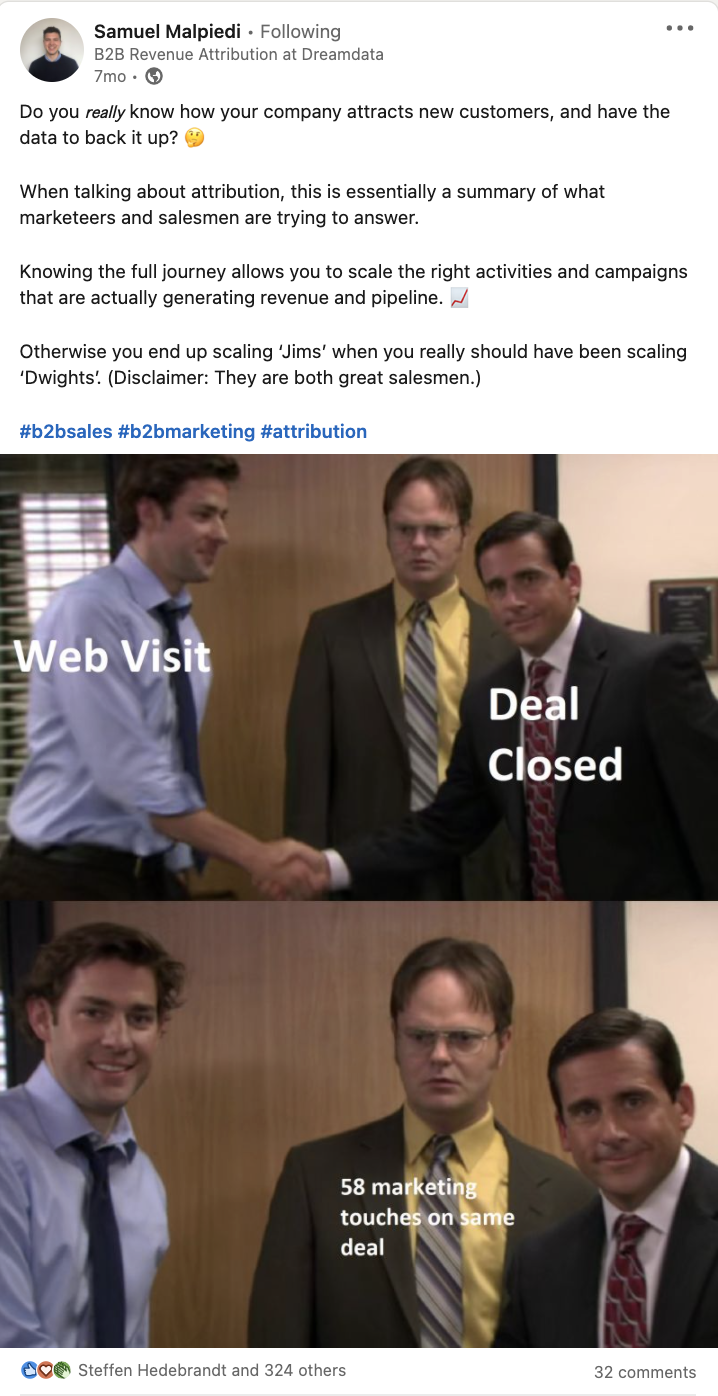
The writer focused more on showing readers the value of knowing the full customer journey, and the post resonated with over 300 people on LinkedIn.
The Dreamdata team also kept a consistent posting cadence—multiple times a week— and they motivated and kept each other accountable.
The increase in post views further positioned Dreamdata as an authority for B2B Attribution. According to the case study, successful LinkedIn posts led to the activation of accounts they had tried to address outbound for months without luck.
With these results came the fulfillment of a promise made:

Dreamdata’s results are proof that social selling not only positions your brand as an authority but also amplifies employees’ voices, elevating your brand more.
The Dreamdata team is now being invited to speak on podcasts and other opportunities that’ll increase brand awareness and establish the brand’s authority.
The reason this strategy worked wonders for the brand is that Dreamdata focused on building relationships through educational and engaging storytelling, social proof, and showing their product in action.
As a result, they became an authority in the eyes of prospects, had shorter sales cycles, drove traffic and signups, closed deals they’d tried to close outbound leveraging individual posts, and generated new revenue opportunities.
Creating relevant content as a part of social selling makes you a reliable guide. In addition to consistency and a great product, you’ll have increased trust, a shorter sales cycle, and more conversions with social selling.
KEY TAKEAWAYS:
- Dreamdata released a case study that broke down how 6 of its employees generated over 520K views and lots of reactions on LinkedIn in 91 days.
- The company leveraged social selling to find the right prospects, nurture relationships, and hit their revenue goals.
- If you collaborate with employees to do social selling right, you will become a reliable guide in the eyes of prospects, close deals, and amplify your brand’s voice.
Two Bootstrapped Startups Became Unicorns
There are two primary ways most startups generate funding for their business: offering products/services to customers or attracting angel investors, VCs, or other sources.
Relying on your own savings and revenue to grow your business is often unappealing to startups, especially because it sometimes isn’t enough to execute the growth plans you have.
(In Nigeria, we call the stress that comes with insufficient funds “suffer-head.”)
As a result, startups seek out angel investors.
While getting venture capital is a great idea, some startups think the funding is the end of their troubles and all they need to succeed.
As a result, about 25% to 30% of venture-backed startups fail, and about 75% of VC-backed businesses in the US don’t return investors’ capital.
Take Tink Labs for instance.

Founded in 2012, the company provided a solution to help international guests eliminate roaming fees. They gave hotels smartphones guests could use to make free calls.
Within 7 years, the company became one of Hong Kong’s unicorns, raising over $170 million in funding, with more than 12 million customers from over 1,700 hotel locations.
However, in August 2019, Tink Labs shut down due to misappropriation of funds and a shift in the market. Lower roaming fees meant customers could now do without them.
Of course, this isn’t to say that VC-backed startups don’t succeed. Rather, it’s to show that massive capital is only a fraction of what a startup needs to succeed.
Mailchimp is an example of a bootstrapped company that rose through the ranks to become a unicorn. The 20-year-old company focused on building a customer-centric brand—they mastered the needs of users/prospects’ and delighted them consistently.
Here’s what Mailchimp’s timeline looks like:

Mailchimp understood that small businesses wanted to succeed even with a shoe-string budget. As a result, they offered a freemium and affordable pricing options for users.
Mailchimp also ensured the product was fully functional—they didn’t compromise on quality despite not charging high fees. Users could customize email campaigns with numerous templates, without needing to know how to design.
They also invested in content marketing as well, educating users on their problems and how they can solve them.
Here’s what their search scorecard looks like at the time of this writing:
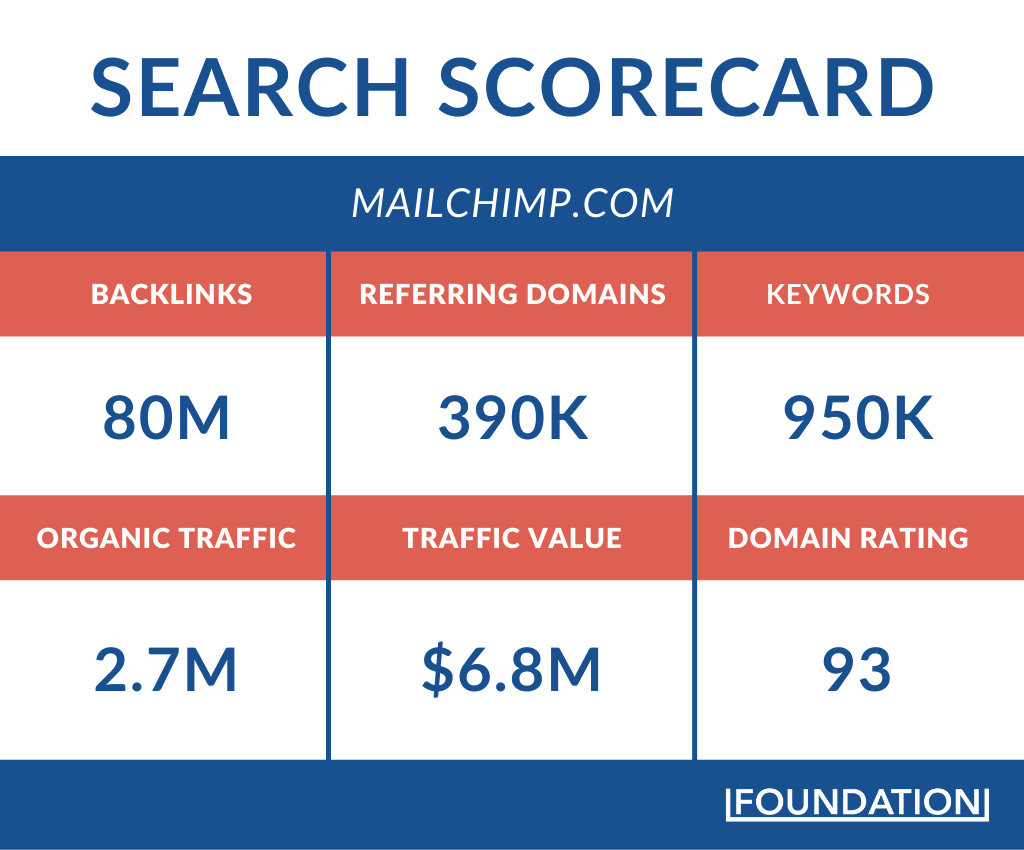
The top-performing keywords show Mailchimp dominating the SERPs for high-value content marketing keywords, with a good volume of search traffic coming from these keywords.
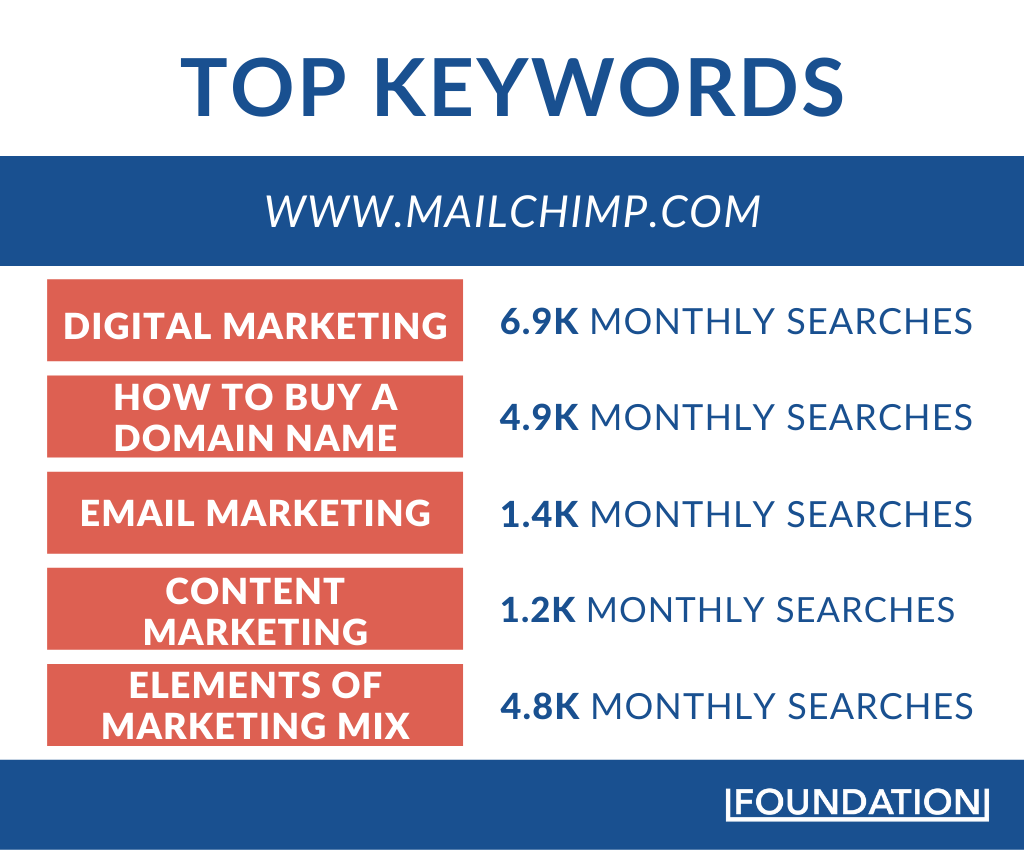
Mailchimp also recently launched its digital magazine, Bloom Season, to empower black-owned small businesses, with practical tips and success stories from successful black entrepreneurs, to reshape how these businesses think of success.
Grammarly is also another successfully bootstrapped unicorn, with about 30M people relying on the product to write and sound confident.
The company dominated the SERPs, targeting the right keywords and positioning its product as the go-to solution over its competitors, Merriam Webster, Dictionary.com, Hemingway, and others.
Grammarly tops the SERPs for grammar question keywords like:

The goal is to help people looking to understand complex grammatical concepts.
We wrote about the strategy Grammarly used to rise through the ranks, including how they found product-market fit. You can read the full case study here.
What Grammarly and Mailchimp share in common is their deep understanding of their audience’s needs and their commitment to keeping the customer at the center of every product iteration and content marketing effort.
Prospects interacted with their free product and consumed their free content to test the waters before jumping in with both feet. These companies over-delivered on both fronts—content and product—and they’re alive and thriving to date.
Their successes are proof that sufficient capital isn’t always the answer. If you have a strong roadmap, one that keeps customers’ needs at the center of everything you do, you can replicate their successes and thrive for many years to come.
As a startup founder, the key takeaway here is that you should prioritize learning about your customers. Identify growth opportunities you can leverage. Create a solid strategy with your team so that if you decide to get external funding, you’ll put it to good use.
KEY TAKEAWAYS:
- About 25% to 30% of venture-backed startups fail, and about 75% of VC-backed businesses in the US don’t return investors’ capital.
- Mailchimp and Grammarly are examples of bootstrapped companies that rose through the ranks to become unicorns.
- A laser focus on identifying, understanding, and solving customer pain points will help startup founders invest funds wisely and succeed, whether or not they are bootstrapped.
OTHER NEWS OF THE WEEK:
🚶🏾♀️Zendesk ends $4.1 billion SurveyMonkey acquisition after its investors reject the deal.
🎙 LinkedIn rolls out podcast network to feature in-house shows from LinkedIn News and programs from industry experts.
🔎 Reddit launches a Discover tab for its iOS and Android apps to help users find content and communities they may be interested in.
BRAIN FOOD OF THE WEEK:
2021 gave rise to new buzz words like Non-fungible Tokens (NFTs), Metaverse, IRL, Decentralized Finance (DeFi), Web3, and plenty more.
The metaverse, for example, would allow remote teams to interact and collaborate with each other in a virtual environment that feels real. Anyone can buy real estate, go shopping, interact with coworkers, family, and friends, and do other things.
After Facebook’s rebrand, mentions of the metaverse in third-quarter earnings calls rose 349%, according to Blockwork.
Despite the skepticism about the concept, most brands are filing their metaverse trademarks to secure exclusive rights of ownership. The Brooklyn Nets, for example, is the first professional sports team in the US to enter the metaverse:
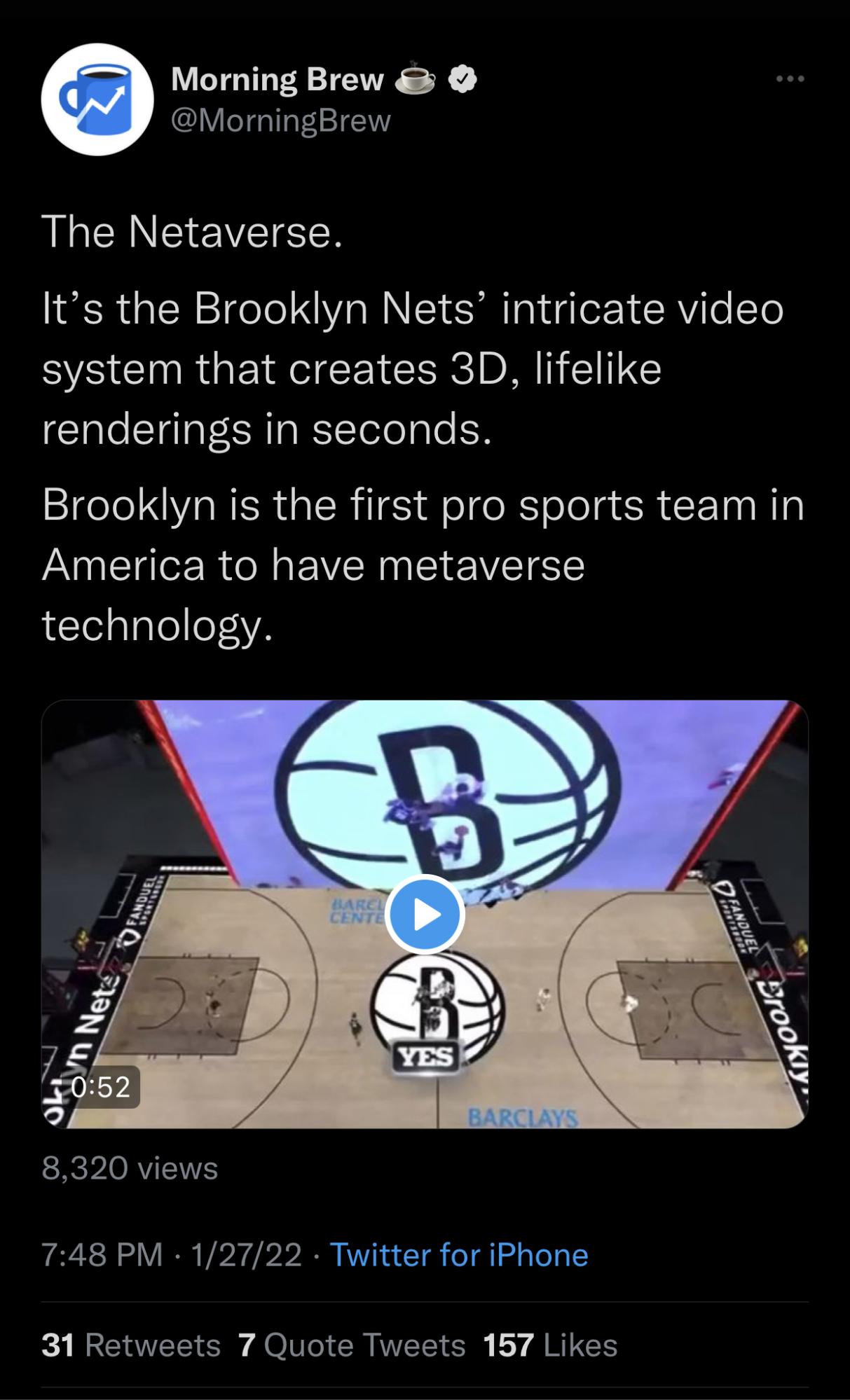
Athletic brands like Puma and Nike have already secured their spot in the blue ocean.
These brands are buying digital real estate for different business reasons.
Hugo Boss, for example, filed the trademark application to sell virtual footwear, clothing, and multiple household items. They also plan on hosting virtual fashion shows in the metaverse. Brands like McDonalds also plan on having virtual restaurants where gamers can stop by to eat.
If you’ve seen Ryan Reynolds’s movie Free Guy, or Wreck-It Ralph (two of my favorite movies, by the way), you’ll know the metaverse would look like the movies’ depiction or even better.
You can check out this article to learn more about which brands have made the move and their future goals for dominating the metaverse.
TWITTER THREAD OF THE WEEK:
17 hand-picked no-fluff marketing newsletters by AbdulGaniy Shehu
IN CASE YOU MISSED SOME OF OUR GREATEST HITS:
- Ross Simmonds on Content Marketing and Hustle Culture
- How Outreach Is Using Employees & Empowerment To Win on LinkedIn
- How To Test Your Ideas Before You Write
- Write Better Headlines, From The Pros At LinkedIn
- Gong’s LinkedIn Strategy: Breaking Through Social Media Noise
WHAT WE’RE WIRED INTO THIS WEEK 🎧:
Love Sux – Avril Lavigne (Because… 00’s)
These round-ups are brought to you by me, Jessica O., every week ✌!







